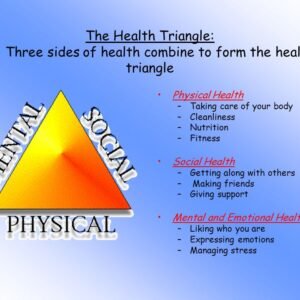The concept of the Health Triangle is a foundational framework in health education that emphasizes the interconnectedness of various aspects of well-being. It highlights the balance between physical, mental, and social health as crucial for overall wellness. Understanding the Health Triangle and its components can help individuals achieve a more holistic approach to health and wellness.
What Is the Health Triangle?
The Health Triangle is a model used to represent the three core components of health:
Physical Health:
This aspect pertains to the state of the body and its ability to function efficiently. It encompasses regular exercise, a balanced diet, sufficient sleep, and the absence of illness or disease. Physical health is often the most visible aspect of health and includes maintaining a healthy weight, managing chronic conditions, and engaging in preventive health measures.
Mental Health:
Mental health refers to cognitive and emotional well-being. It includes the ability to manage stress, maintain a positive outlook, and cope with life’s challenges effectively. Mental health is crucial for making sound decisions, maintaining relationships, and achieving personal goals. It involves mental resilience, emotional stability, and a healthy self-image.
Social Health:
Social health involves the quality of relationships and interactions with others. It includes building and maintaining supportive relationships, effective communication, and a sense of belonging within a community. Good social health fosters positive connections with family, friends, and peers, and contributes to overall life satisfaction.
Why the Health Triangle Matters
Balance and Interconnection:
The Health Triangle illustrates that physical, mental, and social health are interconnected. An imbalance in one area can affect the others. For example, chronic physical illness may lead to stress and anxiety, impacting mental health. Conversely, poor mental health can lead to neglect of physical health or strained social relationships. Maintaining balance across these areas is crucial for overall well-being.
Holistic Approach:
Emphasizing the Health Triangle encourages a more holistic approach to health. Rather than focusing solely on physical fitness or mental health in isolation, this model promotes a comprehensive view of wellness that includes all aspects of life. This approach can lead to more effective and sustainable health practices.
Prevention and Management:
Understanding the Health Triangle can aid in both preventing and managing health issues. For example, addressing mental health challenges may improve physical health outcomes and enhance social interactions. By recognizing the interconnected nature of these components, individuals can develop more effective strategies for maintaining overall health.
Improved Quality of Life:
Striving for balance in What is the health triangle, can lead to an improved quality of life. By focusing on physical health, mental well-being, and social connections, individuals can achieve a more fulfilling and satisfying life. This balanced approach helps in achieving personal goals, enhancing relationships, and fostering resilience against life’s challenges.
Practical Applications of the Health Triangle
Setting Goals:
When setting health-related goals, consider all three aspects of the Health Triangle. For instance, if aiming to improve physical fitness, also consider how exercise impacts mental health and social interactions. Integrating all components into goal-setting can lead to more comprehensive and achievable outcomes.
Daily Routines:
Incorporate practices that address each side of the Health Triangle into daily routines. This might include regular physical activity, stress management techniques such as mindfulness or meditation, and maintaining healthy social connections through meaningful interactions.
Seeking Support:
Recognize when one aspect of the Health Triangle may need more attention. For example, if experiencing high levels of stress, seek support from mental health professionals while also addressing physical health through exercise and nutrition. Engaging in social support networks can also be beneficial.
Education and Awareness:
Educate yourself and others about the importance of the Health Triangle. Awareness of how these components affect one another can lead to better health practices and promote a more balanced lifestyle.
Conclusion
The Health Triangle is a valuable concept for understanding and managing overall well-being. By recognizing the interdependence of physical, mental, and social health, individuals can pursue a more balanced and comprehensive approach to health. Emphasizing the interconnected nature of these components encourages a holistic view of wellness, leading to improved quality of life and more effective health management strategies. Integrating practices that support all three aspects of the Health Triangle can help individuals achieve a healthier, more fulfilling life.
